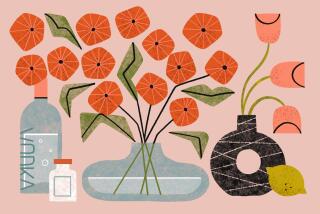Variety, Blooming Time Key to Growing Flowers for Cutting : GARDENING
The cut-flower garden combines the ornamental richness of perennials with the productivity of annuals. Indeed, no other blend more satisfactorily delivers cottage-garden charm without the time and commitment required for a cutting garden of perennials alone.
The cut-flower garden is grown, simply, to provide a wide array of flowers for indoor bouquets. Traditionally, it was planted as part of the “working” garden, the site that served as the primary source of food and medicine for communities.
Today, the tradition of cut-flower beds as part of the back-yard garden continues in many parts of the world, especially Europe. In American gardens, it is still somewhat rare. But there is a demand for cut flowers: Witness the success of market gardeners and farmers who sell them at farmers’ markets.
Flowers for cutting are grown in the same enriched garden soil that suits hard-working vegetable varieties: plenty of organic matter, a neutral pH ranging from 6.5 to 7.5, good drainage and a tilled or dug depth of six to eight inches.
A boost of organic fertilizer before seeds are sown or seedlings planted is always a good idea. The cut-flower garden, like the vegetable garden, will require periodic applications of the same fertilizer, when plants are 2 to 3 weeks old, again one month later and later as needed.
Many prefer organic fertilizers because they don’t cause excessive foliage growth at the expense of flower production. A formula containing nitrogen, phosphorus and potassium (N-P-K) within a couple of numbers of each other (5-4-2 or 8-6-4, for example) is good. And there is a wonderful forgiving quality about organic fertilizers: The concentrations don’t have to be precise.
Cut-flower gardens are less flexible when it comes to sunlight. The sunnier the better. This doesn’t mean you have to give over the choicest sunny spot in the garden to them--many blooms will fit into a small area, say, four feet square. Also, they can be planted within or around the vegetable garden or in an existing border.
The flowers themselves can be a combination of annuals and perennials or all annuals. The goal is to have a variety of flowers blooming at all times. It can take years of trial and error and of effort and patience to achieve this in a perennial garden; but with annuals, which bloom continuously all summer, getting a good selection for indoor bouquets is nearly instantaneous, once plants are established.
In selecting flowers, consider what you want, whether it is ease of care, height, scent, color or flower form. The availability of plants in garden centers also will influence what will go into the cut-flower garden, although many excellent annuals can be sown from seed.
Plants that grow tall are more versatile as cut flowers than dwarf or miniature varieties. Flower stems on tall varieties are generally longer than on small ones, and the foliage itself can contribute to dramatic arrangements.
In this regard, cosmos stands out as one of the most desirable and useful of the cutting flowers. Easily grown from seed, this rugged annual belies the delicacy of its bloom and foliage.
Cosmos comes in a range of colors and even styles. There are two distinct strains, one producing sunny yellow, gold and orange ruffled blooms and the other sporting fragile-looking daisy-faced blossoms in shades of deep red, pink, purple, lilac and white. Today’s varieties include scalloped, ruffled, single and double flowers. All make stunning cut flowers, either alone or in combination with others. Depending on the variety, cosmos ranges in height from two to five feet, and the taller--and most commonly available--ones will need support, either against a wall or trellis or with caging.
For scent, nicotiana is a good choice. This aromatic member of the tobacco family produces a profusion of slightly trumpeted, open-faced blooms, varieties ranging in color from deep red to white, with pinks in between. There is a dwarf version, which gets up to about two feet tall; the traditional form grows to three or sometimes four feet. Other scented annuals that lend themselves to cutting include stock, sweet peas and nasturtium.
For sheer endurance, one of the most reliable annuals is the zinnia. For some reason there seem to be fewer choices of this trusty variety than there once were. Cut and Come Again is perhaps the most durable of the zinnias, yielding an abundance of brilliant, multicolored blooms between two and three inches across, borne atop stiff stems. Their name reflects reality--the more you cut them, the more they’ll bloom.
Generally, this rule applies to all annual flowers. The cut-flower garden is primarily a harvesting garden, handled the same way as tomatoes or strawberries. If flowers are left to mature into seed pods, plants will tend to stop blooming. In addition, most the annuals withstand and even benefit from severe pruning of the sort that accompanies harvesting for bouquets--foliage and all.






